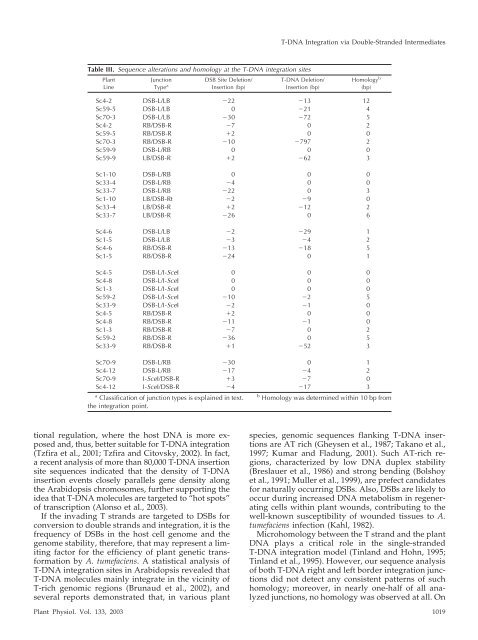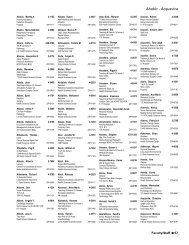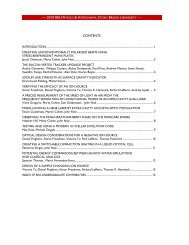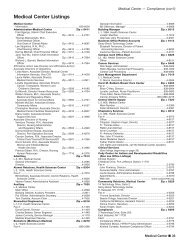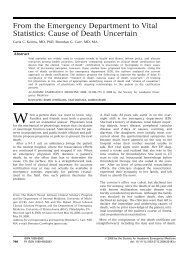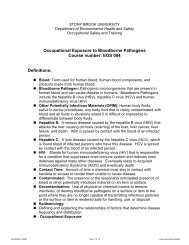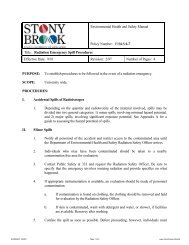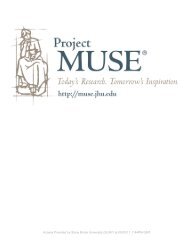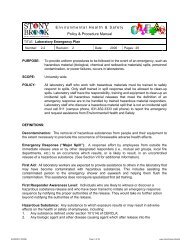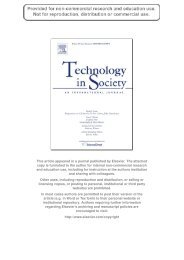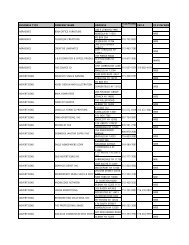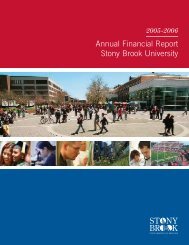Plant Physiology - Stony Brook University
Plant Physiology - Stony Brook University
Plant Physiology - Stony Brook University
You also want an ePaper? Increase the reach of your titles
YUMPU automatically turns print PDFs into web optimized ePapers that Google loves.
Table III. Sequence alterations and homology at the T-DNA integration sites<br />
<strong>Plant</strong><br />
Line<br />
Junction<br />
Type a<br />
DSB Site Deletion/<br />
Insertion (bp)<br />
tional regulation, where the host DNA is more exposed<br />
and, thus, better suitable for T-DNA integration<br />
(Tzfira et al., 2001; Tzfira and Citovsky, 2002). In fact,<br />
a recent analysis of more than 80,000 T-DNA insertion<br />
site sequences indicated that the density of T-DNA<br />
insertion events closely parallels gene density along<br />
the Arabidopsis chromosomes, further supporting the<br />
idea that T-DNA molecules are targeted to “hot spots”<br />
of transcription (Alonso et al., 2003).<br />
If the invading T strands are targeted to DSBs for<br />
conversion to double strands and integration, it is the<br />
frequency of DSBs in the host cell genome and the<br />
genome stability, therefore, that may represent a limiting<br />
factor for the efficiency of plant genetic transformation<br />
by A. tumefaciens. A statistical analysis of<br />
T-DNA integration sites in Arabidopsis revealed that<br />
T-DNA molecules mainly integrate in the vicinity of<br />
T-rich genomic regions (Brunaud et al., 2002), and<br />
several reports demonstrated that, in various plant<br />
T-DNA Integration via Double-Stranded Intermediates<br />
T-DNA Deletion/<br />
Insertion (bp)<br />
Homology b<br />
(bp)<br />
Sc4-2 DSB-L/LB �22 �13 12<br />
Sc59-5 DSB-L/LB 0 �21 4<br />
Sc70-3 DSB-L/LB �30 �72 5<br />
Sc4-2 RB/DSB-R �7 0 2<br />
Sc59-5 RB/DSB-R �2 0 0<br />
Sc70-3 RB/DSB-R �10 �797 2<br />
Sc59-9 DSB-L/RB 0 0 0<br />
Sc59-9 LB/DSB-R �2 �62 3<br />
Sc1-10 DSB-L/RB 0 0 0<br />
Sc33-4 DSB-L/RB �4 0 0<br />
Sc33-7 DSB-L/RB �22 0 3<br />
Sc1-10 LB/DSB-Rt �2 �9 0<br />
Sc33-4 LB/DSB-R �2 �12 2<br />
Sc33-7 LB/DSB-R �26 0 6<br />
Sc4-6 DSB-L/LB �2 �29 1<br />
Sc1-5 DSB-L/LB �3 �4 2<br />
Sc4-6 RB/DSB-R �13 �18 5<br />
Sc1-5 RB/DSB-R �24 0 1<br />
Sc4-5 DSB-L/I-SceI 0 0 0<br />
Sc4-8 DSB-L/I-SceI 0 0 0<br />
Sc1-3 DSB-L/I-SceI 0 0 0<br />
Sc59-2 DSB-L/I-SceI �10 �2 5<br />
Sc33-9 DSB-L/I-SceI �2 �1 0<br />
Sc4-5 RB/DSB-R �2 0 0<br />
Sc4-8 RB/DSB-R �11 �1 0<br />
Sc1-3 RB/DSB-R �7 0 2<br />
Sc59-2 RB/DSB-R �36 0 5<br />
Sc33-9 RB/DSB-R �1 �52 3<br />
Sc70-9 DSB-L/RB �30 0 1<br />
Sc4-12 DSB-L/RB �17 �4 2<br />
Sc70-9 I-SceI/DSB-R �3 �7 0<br />
Sc4-12 I-SceI/DSB-R �4 �17 3<br />
a<br />
Classification of junction types is explained in text.<br />
the integration point.<br />
b<br />
Homology was determined within 10 bp from<br />
species, genomic sequences flanking T-DNA insertions<br />
are AT rich (Gheysen et al., 1987; Takano et al.,<br />
1997; Kumar and Fladung, 2001). Such AT-rich regions,<br />
characterized by low DNA duplex stability<br />
(Breslauer et al., 1986) and strong bending (Bolshoy<br />
et al., 1991; Muller et al., 1999), are prefect candidates<br />
for naturally occurring DSBs. Also, DSBs are likely to<br />
occur during increased DNA metabolism in regenerating<br />
cells within plant wounds, contributing to the<br />
well-known susceptibility of wounded tissues to A.<br />
tumefaciens infection (Kahl, 1982).<br />
Microhomology between the T strand and the plant<br />
DNA plays a critical role in the single-stranded<br />
T-DNA integration model (Tinland and Hohn, 1995;<br />
Tinland et al., 1995). However, our sequence analysis<br />
of both T-DNA right and left border integration junctions<br />
did not detect any consistent patterns of such<br />
homology; moreover, in nearly one-half of all analyzed<br />
junctions, no homology was observed at all. On<br />
<strong>Plant</strong> Physiol. Vol. 133, 2003 1019


